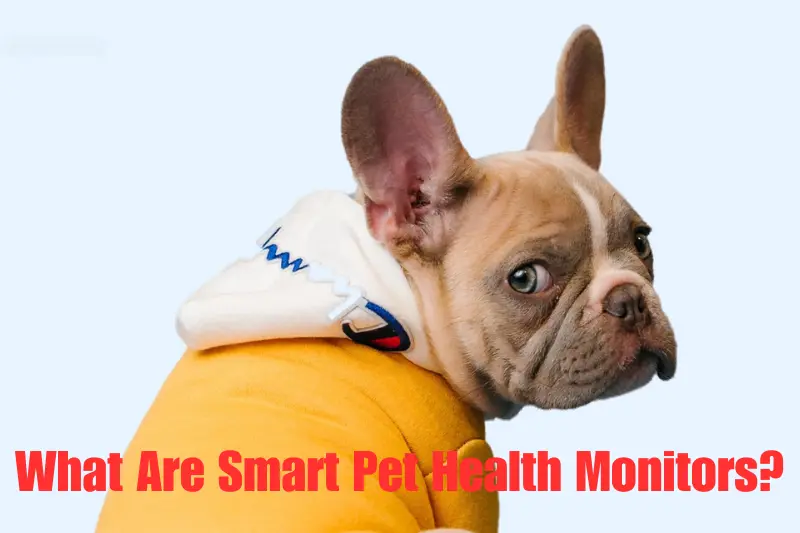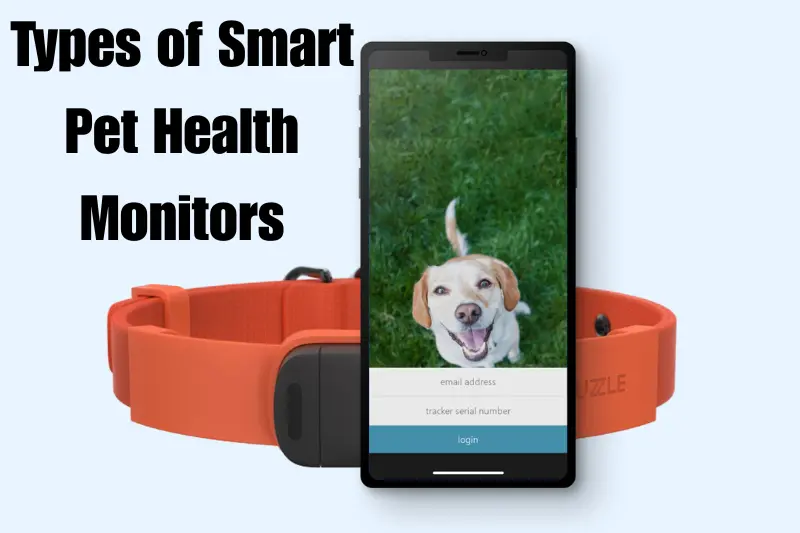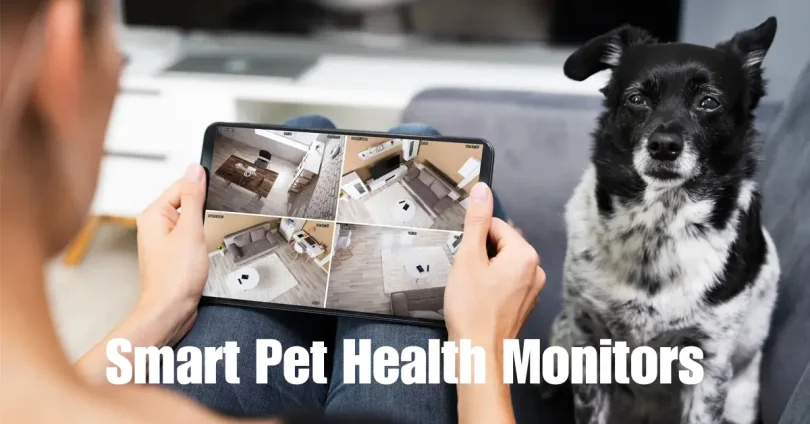If you’re a pet parent, you know just how important it is to keep your furry companion healthy and happy. But pets can’t tell us when they’re not feeling well — and that’s where smart pet health monitors are changing the game. As technology transforms human healthcare through digital tools and remote patient monitoring, it’s also revolutionizing how we care for our pets.
With the pet healthcare market growing rapidly — over 60% of U.S. households own at least one pet — it makes sense that tech innovations are stepping in to offer better, smarter ways to monitor pet health. In this guide, we’ll dive deep into what smart pet health monitors are, how they work, the types available, and why every pet owner should consider using one.
What Are Smart Pet Health Monitors?

Simply put, smart pet health monitors are devices that use technology to track, analyze, and report various aspects of your pet’s health. These can be wearable gadgets like collars and harnesses, or non-wearable devices like smart bowls and litter boxes.
By combining technologies like Artificial Intelligence (AI), the Internet of Things (IoT), and even blockchain, these monitors collect real-time data on your pet’s:
- Physical activity
- Heart rate and respiration
- Behavior patterns
- Sleep quality
- Diet and hydration
- Bathroom habits
They don’t just collect this data—they analyze it to give you insights, alerts, and recommendations to improve your pet’s care. It’s like having a personal vet assistant at home 24/7.
Why Pet Parents Love Smart Health Monitors
There’s a reason why smart pet health monitors are gaining so much attention. Here are some of the biggest benefits:
1. Early Detection of Health Issues
Smart monitors track subtle changes that may go unnoticed. For example, a drop in activity or unusual bathroom habits could signal a health problem. Catching these signs early helps prevent emergencies and costly vet visits.
2. Personalized Pet Care
Every pet is unique, and smart health monitors learn your pet’s normal behavior and health patterns. This allows the system to personalize alerts and insights just for your pet.
3. Convenience and Peace of Mind
Whether you’re working late or away on vacation, you can still check your pet’s health data in real-time using your smartphone. Many apps also allow you to share this data with your vet instantly.
You may also like to read this:
Top Smart Collars For Dogs with GPS & Health Tracking
Best Dog GPS Trackers Online For Safety & Real-Time Tracking
Best Robotic Pet Toys For Dogs And Cats In 2025 Guide
Buy Dog Tech Gear Online – Top Tech For Dogs In 2025
Top Dog Wearable Devices For Health And Safety In 2025
4. Better Communication With Your Vet
When you visit the vet, you can show them a complete picture of your pet’s health over time. No more guessing or forgetting — the data tells the story.
Types of Smart Pet Health Monitors

There’s a wide range of smart devices available to monitor different aspects of your pet’s health. Here’s a breakdown:
1. Smart Collars and Wearable Trackers
These are like fitness trackers for pets. Worn around the neck, they measure:
- Steps and activity levels
- Heart and respiratory rate
- Sleep patterns
- Body temperature
- Behavioral changes
Some even include GPS to track location — perfect for adventurous pets.
Popular brands: Whistle, FitBark, PetPace
2. Smart Food and Water Bowls
Monitoring your pet’s nutrition is just as important. These bowls track:
- Meal portions
- Feeding times
- Water intake
If your pet suddenly drinks less water or skips a meal, the device will send you an alert — helping you catch early signs of illness.
Popular brands: SureFeed, PETKIT
3. Smart Litter Boxes (For Cats)
Yes, even litter boxes are getting smarter. These high-tech toilets track:
- Urination and defecation frequency
- Waste volume
- Weight changes
This data helps detect urinary issues, digestive problems, or dehydration in cats — which are often hard to spot until it’s serious.
Popular brands: Litter-Robot, PurrSong LavvieBot
4. Pet Health Monitoring Cameras
These are more than just surveillance cameras. They analyze your pet’s movement, vocalizations, and behavior while you’re away. Some come with interactive features, such as treat dispensers and two-way audio.
Popular brands: Furbo, Petcube
5. Smart Beds and Mats
These devices monitor your pet’s vital signs and rest periods while they sleep. Some can even detect breathing patterns and signs of pain or discomfort.
How Smart Technology Powers These Devices
What makes smart pet health monitors truly “smart” isn’t just their sleek design or wireless functionality—it’s the powerful technology behind them. These devices leverage cutting-edge advancements like Artificial Intelligence (AI), the Internet of Things (IoT), and even Blockchain to deliver real-time, accurate, and actionable insights into your pet’s health. Here’s how each technology contributes:
🧠 Artificial Intelligence (AI): Personalized Insights in Real-Time
AI is at the heart of most smart pet health monitors. These systems use machine learning algorithms to analyze your pet’s daily habits, movements, and behaviors. Over time, they create a baseline of what’s “normal” for your specific pet.
- If your dog usually walks 5,000 steps a day but suddenly drops to 1,000, the AI detects this deviation and alerts you.
- AI also monitors for anomalous behaviors, such as excessive scratching, changes in sleep patterns, or restlessness—all of which may indicate underlying health issues.
- Some advanced systems even predict potential health risks, giving you time to intervene before a condition worsens.
This continuous learning makes AI incredibly powerful—it doesn’t just record data, it understands your pet better over time.
🌐 Internet of Things (IoT): Seamless Health Tracking Across Devices
The IoT refers to a network of connected smart devices that communicate with one another. In pet health, this means your smart collar, feeder, litter box, water bowl, and even the vet’s software can all sync data to a centralized dashboard or mobile app.
- For example, if a smart feeder logs reduced food intake, and the litter monitor shows less bathroom activity, the system can flag a potential digestive issue.
- IoT allows for holistic health tracking, as all the data is gathered in one place—giving you and your vet a comprehensive view of your pet’s health trends.
Thanks to IoT, these devices work together like a digital health team, helping you manage your pet’s wellness without having to guess or switch between multiple platforms.
🔐 Blockchain: Securing Your Pet’s Health Data
In an age where data privacy is a growing concern, some smart pet health platforms are now using blockchain technology to enhance security.
- Blockchain creates a tamper-proof, decentralized record of your pet’s health history—each update is securely encrypted and cannot be altered without authorization.
- This is especially valuable for sharing medical records with veterinarians, pet sitters, or insurance companies, as the integrity of the information is guaranteed.
- Blockchain also allows greater transparency, as pet owners have full control over who accesses their data and how it’s used.
While still emerging in the pet tech space, blockchain adds an extra layer of trust and accountability to your pet’s digital health ecosystem.
Real-World Examples: How Owners Use Smart Pet Health Monitors
Imagine this:
- Your dog wears a smart collar that tracks heart rate and activity.
- A connected food bowl monitors how much they eat daily.
- A mobile app shows if they’re exercising less or skipping meals.
- You get a notification that their behavior is different today.
- You take them to the vet early — and catch an infection before it becomes serious.
These real-time insights can literally save lives.
Are Smart Pet Health Monitors Worth It?
Short answer: Yes — absolutely.
If you’re wondering whether investing in a smart pet health monitor is just another tech fad or a real game-changer, the answer lies in the value it brings to your pet’s health and your peace of mind. These devices are especially worth it for specific types of pets and owners. Here’s why:
🐾 Senior Pets Who Need Closer Monitoring
As pets age, they often become more prone to issues like arthritis, weight gain, diabetes, or cognitive decline. Smart monitors can help track:
- Changes in mobility (reduced walking, limping, etc.)
- Altered sleep cycles or bathroom habits
- Increased or decreased appetite
These real-time insights allow you to spot early warning signs and consult a vet before a condition worsens — potentially improving your pet’s quality of life and longevity.
🏥 Pets with Chronic Conditions
For pets with ongoing health problems like diabetes, epilepsy, allergies, or heart conditions, constant monitoring is essential. Smart devices can:
- Track vital signs such as heart rate or temperature (depending on the device)
- Log food and water intake
- Alert you to irregular patterns, such as seizures or labored breathing
Having this data at your fingertips helps you and your vet manage conditions more effectively and adjust treatment plans based on actual trends, not guesswork.
⏰ Busy Pet Owners Who Want Peace of Mind
If you’re working long hours or frequently away from home, smart pet health monitors can be a lifesaver — literally.
- Some devices offer live video streaming, so you can check in on your pet anytime.
- Activity trackers ensure your pet is getting enough exercise during the day.
- Smart feeders and water bowls can monitor consumption when you’re not around.
These features help ease the worry of being away and make sure your pet is still getting the care and attention they need.
📱 Tech-Savvy Pet Parents Who Love Data-Driven Care
If you’re the type of pet parent who tracks your own fitness or sleep with a smartwatch, why not do the same for your furry friend?
- Smart monitors provide daily, weekly, and monthly health reports
- Many apps offer goal-setting (like weight targets or activity milestones)
- You can sync data with your vet and even store medical records digitally
This not only makes caring for your pet more organized and efficient, but also deeply personalized.
💰 Is It Worth the Price?
Sure, the initial cost of some smart pet health devices can seem high, ranging from $50 to over $300 depending on the features. But when you weigh the benefits, the investment often pays for itself:
- Early detection of health issues can save on expensive emergency vet bills.
- Better condition management reduces the need for frequent visits or tests.
- Peace of mind is priceless when you know your pet is safe and healthy, even when you’re not there.
In the long run, these devices can lead to healthier, happier pets and lower veterinary costs — making them well worth the price for many pet owners.
The Future of Pet Health is Smart
Smart pet health monitors are no longer a luxury — they’re quickly becoming a must-have for responsible pet ownership in the digital age. As these devices continue to improve with AI and IoT, we can expect even more advanced features, from predicting illness before symptoms appear to customizing wellness plans based on genetic profiles.
If you love your pet (and we know you do!), consider making the leap into smart health monitoring. Because your pet deserves the best care — and now, thanks to technology, you can give it to them.
Conclusion
In today’s tech-driven world, Smart Pet Health Monitors are revolutionizing the way we care for our furry friends. From tracking vital signs and behavior patterns to providing early alerts about potential health issues, these smart devices are empowering pet parents with actionable insights and peace of mind.
Whether you’re a busy professional, a tech-savvy pet lover, or a devoted owner of a senior or chronically ill pet, investing in Smart Pet Health Monitors is a proactive step toward ensuring your pet’s long-term health and happiness. As this technology continues to evolve, one thing is clear — the future of pet care is smart, connected, and incredibly compassionate.
FAQs
1. What are Smart Pet Health Monitors?
Smart Pet Health Monitors are high-tech devices that track and analyze various aspects of your pet’s health, such as activity levels, heart rate, sleep, diet, and bathroom habits. They use technologies like AI and IoT to provide real-time insights and alerts.
2. How do Smart Pet Health Monitors work?
These devices collect data from sensors embedded in collars, bowls, litter boxes, or beds. The data is then processed using AI algorithms to detect patterns or abnormalities, which are sent to your smartphone app or dashboard for monitoring.
3. Are Smart Pet Health Monitors suitable for all pets?
Most monitors are designed for dogs and cats, but some models can be used for other small pets. It’s important to choose a device that fits your pet’s size and health needs.
4. Can Smart Pet Health Monitors replace regular vet visits?
No, these devices are meant to supplement veterinary care, not replace it. They provide early warnings and detailed health data to help you and your vet make informed decisions.
5. How accurate are these monitors?
While not a substitute for professional medical equipment, many Smart Pet Health Monitors use advanced sensors and AI to provide highly reliable data. Accuracy improves as the device learns your pet’s normal behavior over time.




